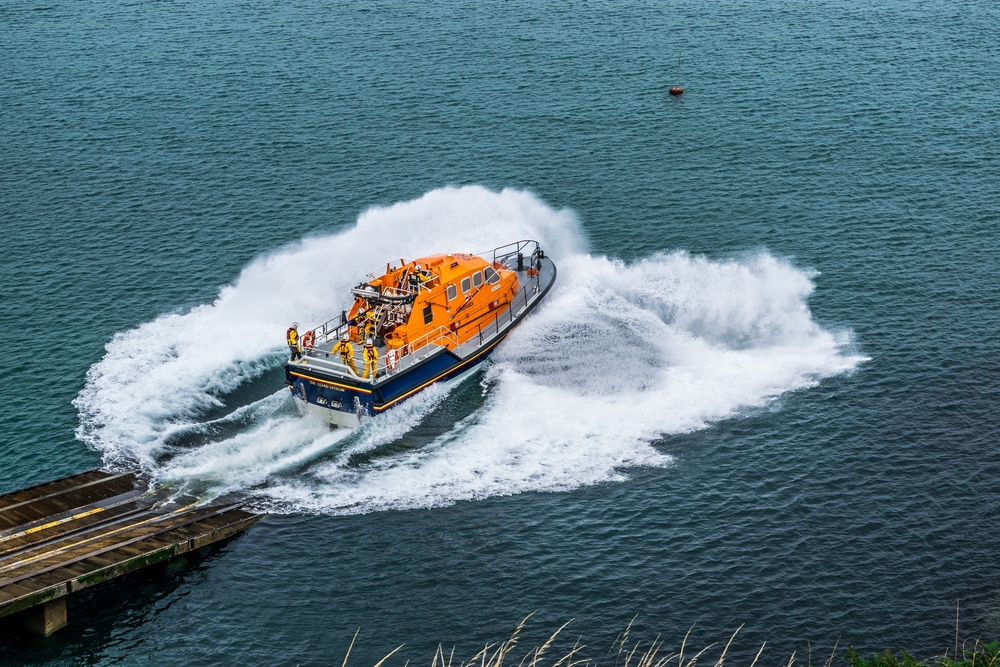If you think of the rugged Cornish coast, you’ll likely picture a few unchanging elements – wild seas, dogged fishing boats and granite cliffs. But that’s not all you can spot when you stand on Cornwall’s shores. You can add to that list the reassuring presence of the RNLI’s orange and blue lifeboats, ensuring safety around our 250 miles of coastline.
The RNLI in Cornwall
The Royal National Lifeboat Institution has been saving lives in Cornish waters for almost 200 years, with the first rescue taking place in 1824. Back then the RNLI focused on shipwrecks – as few people were foolhardy enough to enter the waters without a boat!
Amazingly, the “fourth emergency service” is still run as a charity with the majority of its skilled lifesavers volunteering and potentially risking their lives for free.
Cornwall’s lifeboat stations
There are 14 active lifeboat stations here in Cornwall, with a fleet of 21 lifeboats around the coast – that’s more than any other county in the UK. Each station is built and equipped to suit local conditions, and to facilitate operating different boats and methods of launching. In north Cornwall we have six stations, many of which are open to the public, either on a walk-up basis or by appointment.
- Bude. Since 1837, Bude has hosted a Lifeboat Station and has operated from Summerleaze Beach since 2001. Visits are by appointment only.
- Newquay. The crews here have received several awards for gallantry and currently run two inshore lifeboats. Visitors are welcome in the summer with the shop open from April to December.
- Padstow. The state of the art station at Mother Ivey’s Bay was completed in 2006 and is able to launch lifeboats at any stage of the tide. Padstow is not open to visitors, but you’re welcome to observe Wednesday evening training launches.
- Port Isaac. This pretty station can be found on the harbour slipway sandwiched between posh fish restaurants. Visitors are welcome from 9am until dusk, daily.
- Rock. Serving the Camel estuary since 1988, Rock station is situated on the beach near the ferry. Visiting times are 11am–4pm during the summer and by appointment in winter.
- St Agnes. Viewers of BBC’s Blue Peter may remember their successful lifeboat appeal in the 1980s, which paid for the (now retired) Blue Peter IV. Visits to St Agnes are by appointment only.

How to get involved with the RNLI in Cornwall
The RNLI raises money and awareness at annual events around the county. Here is a selection of some of the best in North Cornwall:
- The Newquay Lifeboat Day, held each July, is the RNLI’s biggest fundraising event of the year. Head to Newquay harbour to watch dramatic rescue demonstrations and learn about the amazing work of RNLI Volunteers.
- Bude RNLI Lifeboat Weekend in late August is a firm favourite with locals and visitors, promising great food, a quiz, live music, dancing and fireworks.
- Port Isaac Lifeboat Larks is also in August and offers live music, barbecues and a Punch and Judy show on the Platt and around the harbour.
- The RNLI Rescue Zone at Cornwall’s National Maritime Museum in Falmouth is fantastic for children (and grown-up children!) with ride-on rescue vehicles, dressing-up and sea safety information.
- Swim Safe offers training for kids during the summer. These fun and free water safety classes are created by Swim England and the RNLI. Currently there are classes in Falmouth and Bude – see their website for more details.
Learn more about beach safety
Alongside their remarkable work at sea, the RNLI can also be found on our beaches during the busy summer months. Over 80 beaches are manned by the organisation’s trained and highly skilled lifeguards.
You should visit the RNLI’s ‘Know the Risks’ website to learn about potential dangers you might face by the sea and pick up top tips of what to do should the occasion arise.
